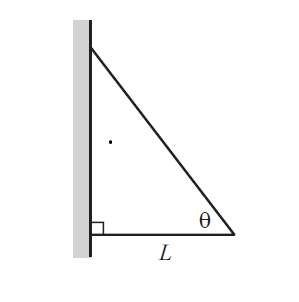Exercise 2.36 Two sticks and a wall

Two sticks are connected, with hinges, to each other and to a wall. The bottom stick is horizontal and has length , and the sticks make an angle of with each other, as shown in Figure above. If both sticks have the same mass per unit length, , find the horizontal and vertical components of the force that the wall exerts on the top hinge.
Also show that the magnitude goes to infinity for both → and →
No vote yet
1 vote
Easy Math Editor
This discussion board is a place to discuss our Daily Challenges and the math and science related to those challenges. Explanations are more than just a solution — they should explain the steps and thinking strategies that you used to obtain the solution. Comments should further the discussion of math and science.
When posting on Brilliant:
*italics*or_italics_**bold**or__bold__paragraph 1
paragraph 2
[example link](https://brilliant.org)> This is a quote# I indented these lines # 4 spaces, and now they show # up as a code block. print "hello world"\(...\)or\[...\]to ensure proper formatting.2 \times 32^{34}a_{i-1}\frac{2}{3}\sqrt{2}\sum_{i=1}^3\sin \theta\boxed{123}Comments
In the above figure, I have marked all the forces that are present in the system. Let the masses of the two rods be m1 and m2.
Thus,
m1=ρLsecθ m2=ρL
Considering the torque about the point A,
h1(Ltanθ)=(m1+m2)g2L
h1(Ltanθ)=ρL(1+secθ)g2L
h1=ρtanθ1+secθ2gL
Ill do the vertical force later..Ill post it as a comment
Log in to reply
Nice explanation
Why are there no forces at the hinge joining the 2 sticks ??
Log in to reply
There are forces at the hinge joining the sticks, but they are internal forces. So, they cancel each other off..
Log in to reply
Got it ! Thanks a lot !!
do you know any good book with exersises in rotational dynamics ;
Log in to reply
Try IE Irodov or Krotov
The vertical force can be found using the pivot point B. It is -(rholg/2)(1+2sec(theta)).